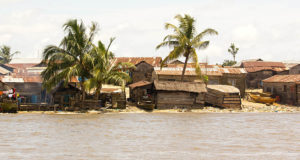At least two people were killed in recent flooding in Dar es Salaam, Tanzania, eight in Durban, South Africa, and 15 in Rubanda, Uganda. Floods are becoming a regular phenomenon in African cities. While climate change contributes to this wave of extreme weather, poor city planning and design, old infrastructure, and a lack of urban policy for slums are also to blame. Until the faulty structures, like non-functioning drainage systems, are updated, floods will accompany seasonal rains, especially in slums.
In Lagos, Nigeria, for instance, a poorly planned drainage system makes flooding a costly annual expense. Houses and offices are built without city permits or adequate systems to remove surface water. When the flood waters rise, slum dwellers’ properties are washed away with their belongings, lives are lost, and economic activity is disrupted. Governments and citizens often skirt around the issue by clearing drains without allocating sufficient resources to address the damage done by the floods. This sets back progress, disrupting people’s health, economic activity, and other aspects of life across the region. But the problem is bigger than Lagos. From Dar es Salaam to Abidjan, Accra to Johannesburg, African cities are playing catch-up with rapid, unplanned urbanization. Thus, while the problem may appear more acute in Lagos, other African cities are also experiencing a strain on existing infrastructure as urban areas become more populous and city officials try to prevent the formation of new slums.
Africans need solutions for the African cities we have. With recurring floods inevitable, insurance companies should offer affordable plans that allow people to more easily recover from storms. There is a market for a well-designed insurance product that helps women in particular who are thriving in informal sector but whose ventures are too fragile to cope with climate-related disasters. Floods destroy dwellings, but, more importantly, they also wash away trading stock and even the working capital under the mattress. Ghana’s digital addressing system could prove a good starting point to develop an insurance scheme to help citizens prepare for climate- and human-enhanced weather events. Other cities should consider the same policy as part of a collection of services that promote financial inclusion. Designing cities with individuals and businesses in mind means providing access to useful and affordable financial products and services.
Insurance is one such product. It could help communities manage the consequences of flood-related disasters. While insurance is a complementary vehicle to drive financial inclusion, Africa also needs to address its growing population, which is expected to increase by 1.3 billion by 2050 reaching a total 2.4 billion. The continent was home to less than 500,000 people in 1950. Africans now have an opportunity to use architecture and design to transform the environment and the lives of the disadvantaged—the majority, rather than just the privileged few. In this respect, John Cary’s book on “design for good” offers a range of options for engaging with the public and using local materials.
To design for good, we should involve community members affected by floods. They should be partners in designing the cities of the future to ensure that large-scale plans accommodate their needs. Governments and leaders of institutions tasked with urban planning need to earn the trust of the community by demonstrating that their intentions are not simply to act in response to an emergency, but to create better opportunities for people in the city. Ultimately, trust will be built when they employ local workers and source local materials and when, in the next floods, fewer lives are lost and the disruption to business is limited.
For a city to be considered “smart,” it needs to make citizen engagement a key part of its vision; develop baselines, set targets, and choose indicators of success; and embrace the principles of a start-up. While cities are becoming increasingly smart, innovation has also kept slums alive. We can learn from the Lagos neighborhood Makoko, for instance: It’s a “smart slum,” designed to harness the features of the surrounding environment and supporting the community ecosystem. In Makoko, houses on the water were built with hardwood, supported by stilts driven deep into the waterbed. Furthermore, 23 neighborhood “hotspots” were constructed to facilitate residents’ access to water, electricity, sanitation, and other services. Smart slums in Dar es Salaam, Abidjan, Accra, and Johannesburg count among their greatest assets the ingenious women, men, and young people who live there. Integrating their knowledge and experience into the broader urban areas using the “design for good” principles will bring progress to everyone and connect city dwellers who live parallel, yet interconnected, lives.
Ultimately, the proof is in the design. Nairobi, Kenya, and Cape Town, South Africa, are set to achieve smart status for leveraging technology to bring people together, improve business and trade, and adopting environmentally friendly practices. But as the foundations of cities crumble under demographic weight, the next step will be to integrate these systems while addressing the challenges, exacerbated by climate change, of insurance and better valuation of assets. Offering protection through a smart insurance scheme to the men and women who strive to turn their small ventures into medium enterprises will add an additional service to the financial inclusion ecosystem.
We have the ability to limit the impact of climate change by re-imagining the interaction between the city and its people. We cannot wait for a collision between demography and urbanization in Lagos, Dar es Salaam, Abidjan, Accra, Johannesburg, and other African cities before we act. Creating smart cities without the input of the people inhabiting them will roll back progress and fail to end annual flooding.

